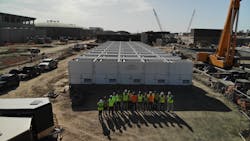Debunking Natural Gas Myths
Over a year has passed since Winter Storm Uri crippled Texas and left most of the state without power. Many of the people I spoke with pointed to the natural gas supply as the culprit. This was often misreported in the news so who could blame them? The fact is that our natural gas network is one of the most reliable energy networks in all North America. There is no correlation between the gas pipeline reliability and the electric utility reliability, therefore it is the perfect solution to provide resiliency to critical operations, like data centers. During the winter storm, the underground pipelines were not really affected by the cold. The issue was that there was a pressure drop from where the line went above ground to where it connects with the giant gas turbines at the utility. These high-pressure, combine-cycle gas turbines need up to 500PSI to operate, and the drop was significant enough to cause issues. A similar drop in pressure would not have impacted a modular configuration of 450KW gas back up generators because they can operate on as little as 5PSI for over a week, if necessary.
One thing Uri did show us is that reliance on renewables such as wind and solar for resilience does not help much when it’s overcast and the wind doesn’t blow for 8 days. Iced over roads also made refueling diesel generators impossible. Once standby batteries and fuel tanks were empty, businesses were forced to sit in the dark and cold like everyone else that did not have a natural gas generator.
Speaking of comparing diesel to natural gas, I often heard people state that because natural gas is a fossil fuel, it is not even being considered as a resiliency option. While, yes, natural gas is a fossil fuel, it is immensely cleaner than diesel when comparing greenhouse gas and carbon emissions. Gas has zero run time limitations since it is not restricted by fuel tank storage capacity. Plus, natural gas generators are capable of performing like their diesel counterparts, from start to full facility power in under 10 seconds. They also can be a direct drop-in replacement for diesel generators, utilizing the same size footprint.
Natural gas isn’t the future, but a resiliency microgrid featuring natural gas, or even renewable natural gas, gets you several steps closer to a negative carbon position, and certainly to a zero carbon solution. One of the things I consistently heard in my conversations at Data Center World was that everyone has made their ESG goals and set their zero carbon pledge dates. A lot of data centers are finding better, more sustainable uses for water and heat, but hardly any are looking to move aways from diesel backup generators. Natural gas is a proven, cleaner, cheaper, and more reliable option that is readily available today.
Erik Brumbaugh is Global Accounts Director – Data Centers at Enchanted Rock. Contact them to learn more about their natural gas solutions for data centers.


